I've had the privilege of exploring Vietnam for thirty years over remarkable times in the country's evolution. We write these guides with an interest in history, culture, food, language - the full story.
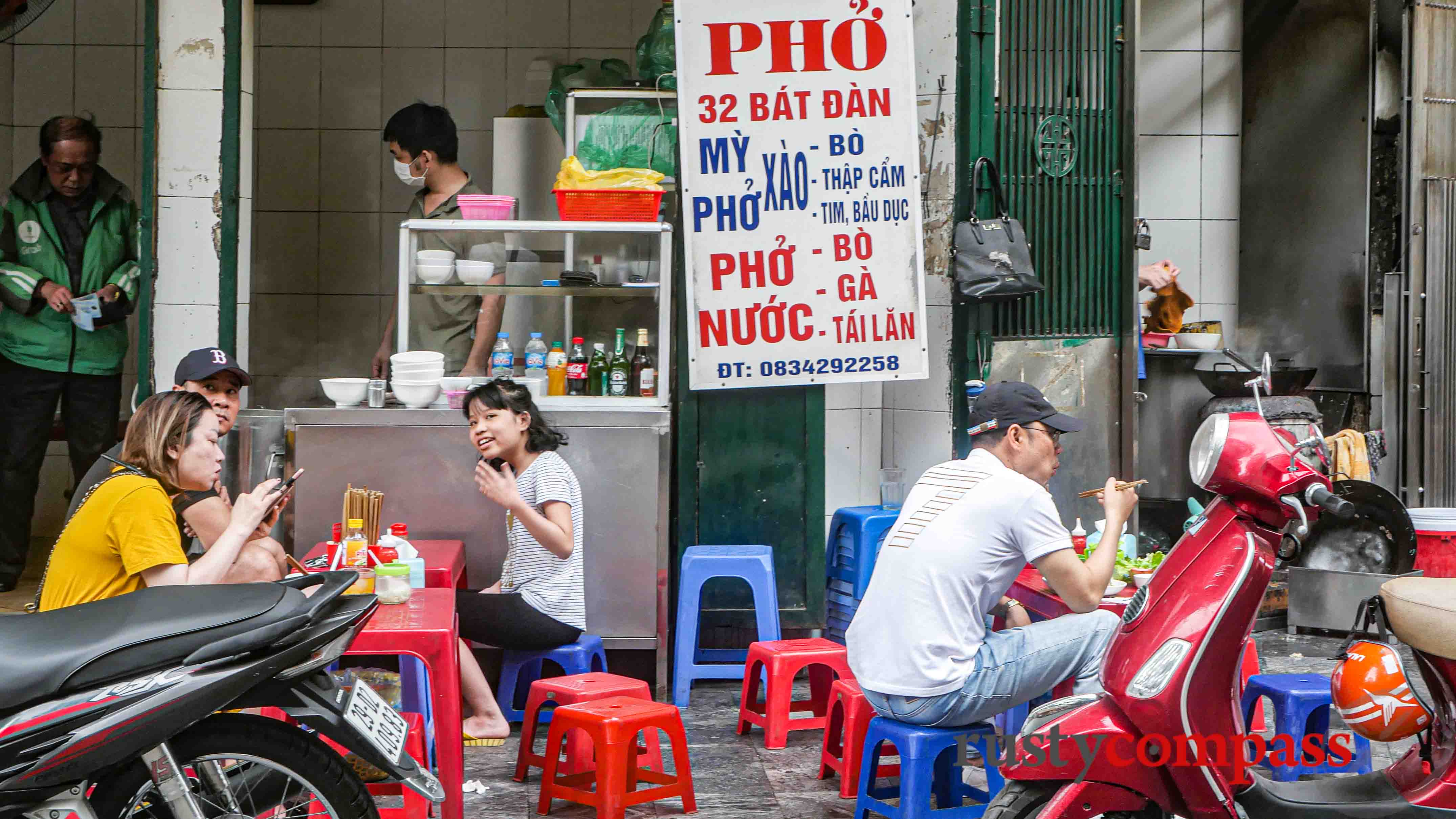
Photo: Mark Bowyer Hanoi - motorbikes, streetfood and energy - photos, video and words - everything on Rusty Compass is original
The past three decades have seen extraordinary and complicated changes in Vietnam and around the world. But I’ve never tired of exploring and engaging with what is a truly extraordinary place. Few foreigners have explored, written about and photographed Vietnam as extensively and for as long as I have.
Check our language classes for travellers and our YouTube channel too.
After three decades, I still love wandering the streets of Hanoi, the mountains of the far north, cycling with locals through lush green rice fields and the frenetic chaos of Saigon. I still love chatting with random people on the streets and in markets. I still love exploring Vietnam's history and culture And I never tire of the delights of Vietnamese cuisine.
Vietnam is changing quickly - too quickly in many ways. But the change is part of what's fascinating. There's extraordinary entrepreneurial energy, creativity, new designs, new approaches. For every heritage tragedy, or environmental problem, or corruption scandal, there are more people determined to make the next day better.
Vietnam's proximity to China has long made it a player on the global geopolitical stage. Today, it finds itself at the centre of the rivalry between its huge ancient northern neighbour, and its twentieth century foe, the United States.
So there's plenty to think about as you explore.
Vietnam offers a perfect combination of cultural and historical depth, exquisite landscapes and cuisine and simple memorable experiences. But it’s the energy of a gregarious, resilient people on a mission to make up for lost time, that makes Vietnam truly unique and unforgettable.
It’s hard to imagine how Vietnam's two major cities, Hanoi, the capital, and Saigon the commercial centre, could be more different. Hanoi retains an aloofness and a sense of its old-world uniqueness, while Saigon, always at full throttle, has managed to hold on to a friendly charm, while struggling to stay ahead of its own momentum.
Many of your best experiences of Vietnam will be had away from the big cities, among the country's breathtaking rural landscapes.
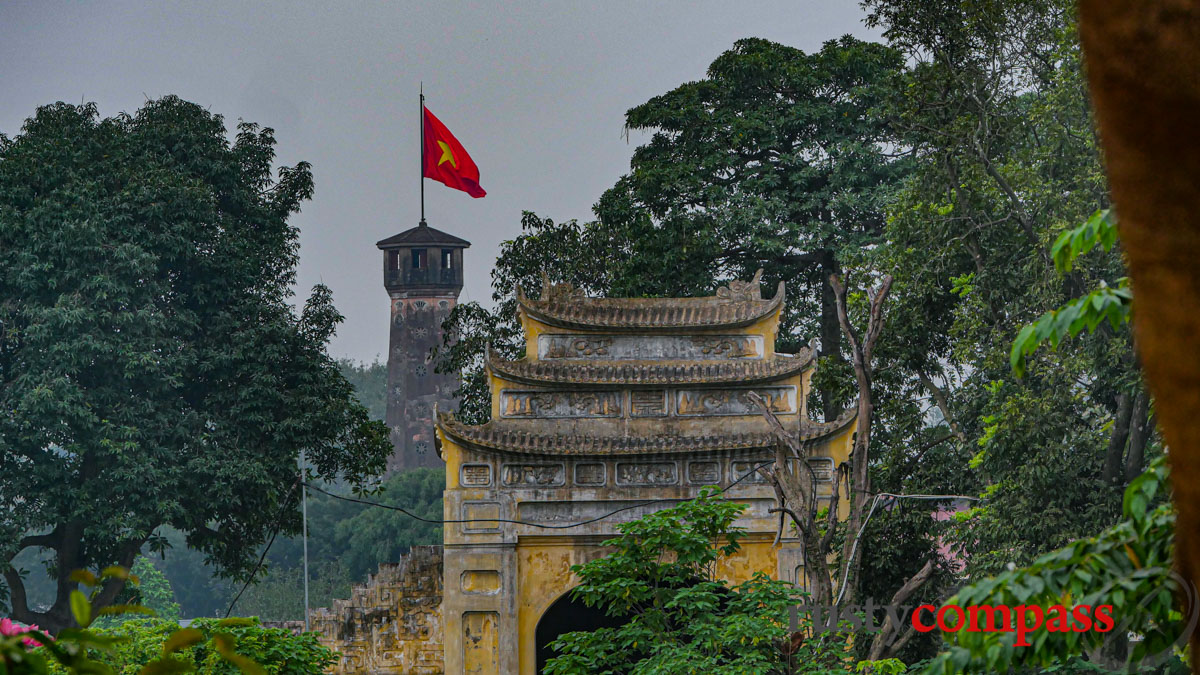
Photo: Mark Bowyer A view of Hanoi unchanged for centuries.
Vietnam in 2024
Vietnam visas in 2024 - SPECIAL NOTE
In 2023, Vietnam announced long overdue improvements to its tourist visa processes. Since then loads of travellers have fallen afoul of an overly complicated process. For many travellers (ASEAN residents, Europeans, Brits), getting into Vietnam is process-free and easier than ever. Travellers from the US, Canada, Australia, New Zealand, Ireland and other places MUST have an approved visa when they arrive at any border gate. Wherever you are travelling from, please check latest visa waiver rules
Please note that there are many suspect websites (including some fake Vietnam government websites) providing visa information. Many of them are platformed in Google ads and Google includes many fake and otherwise dubious Vietnam visa websites in its search results.
As of November 2024, the official website is https://evisa.gov.vn/.
Happily, once you arrive, Vietnam is a much more welcoming place to visit than you might assume from the Immigration website.
Countries enjoying a visa waiver, including ASEAN countries, Europe and the UK and others. Most of these now enjoy 45 day multiple entry access from August 15 2023.PLEASE CHECK THE CONDITIONS APPLICABLE TO YOUR PASSPORT.
United States, Australian and New Zealand passport holders (and many others) are entitled to an evisa that can be obtained via this Vietnam government official evisa portal. Make sure you use this portal if you want an evisa. There are hundreds of companies online proposing to offer Vietnam evisas at inflated prices. Many of them are dodgy and use official-sounding domain names. Google makes the dodgy players visible in search results. Many of them power their dodgy businesses buying ad space on Google too.
The new 15 August 2023 evisa is valid for 3 months with multiple entry permitted.
The evisa form has been described as a Windows 95-style creation. It's clunky and it's easy to make mistakes. Take care as you work through it. It's not a great advertisement for Vietnam's emerging, highly regarded tech sector.
Remember, a legitimate Vietnam government website should have .gov.vn in its URL.
Check carefully the visa situation applicable to your country, and be aware of strict duration limits and re-entry conditions.
Sorry we can't be more helpful! Check carefully.
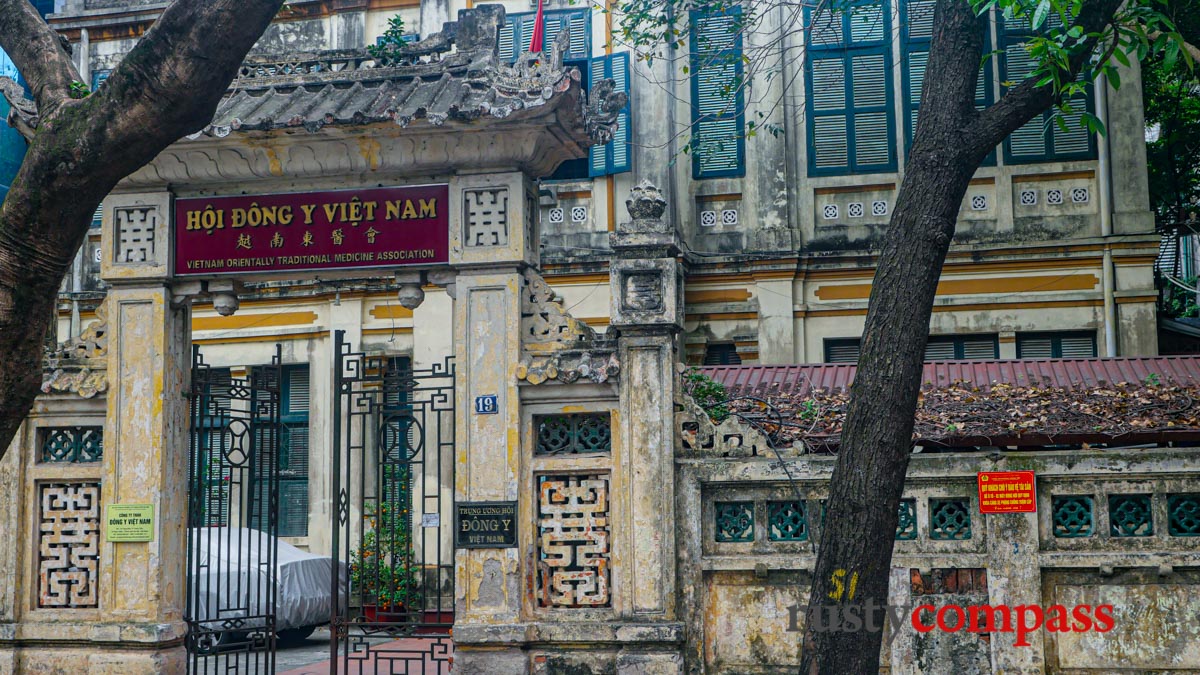
Photo: Mark Bowyer Traditional Medicine Association, Hanoi
Vietnam travel highlights
* The far north - from Ha Giang to Sapa to Dien Bien Phu, Vietnam’s mountainous north is spectacularly beautiful, culturally rich and unique. Not to be missed. Just south of Hanoi, Mai Chau, Pu Luong and Ninh Binh are also wooing travellers in search of mountain landscapes and traditional life.
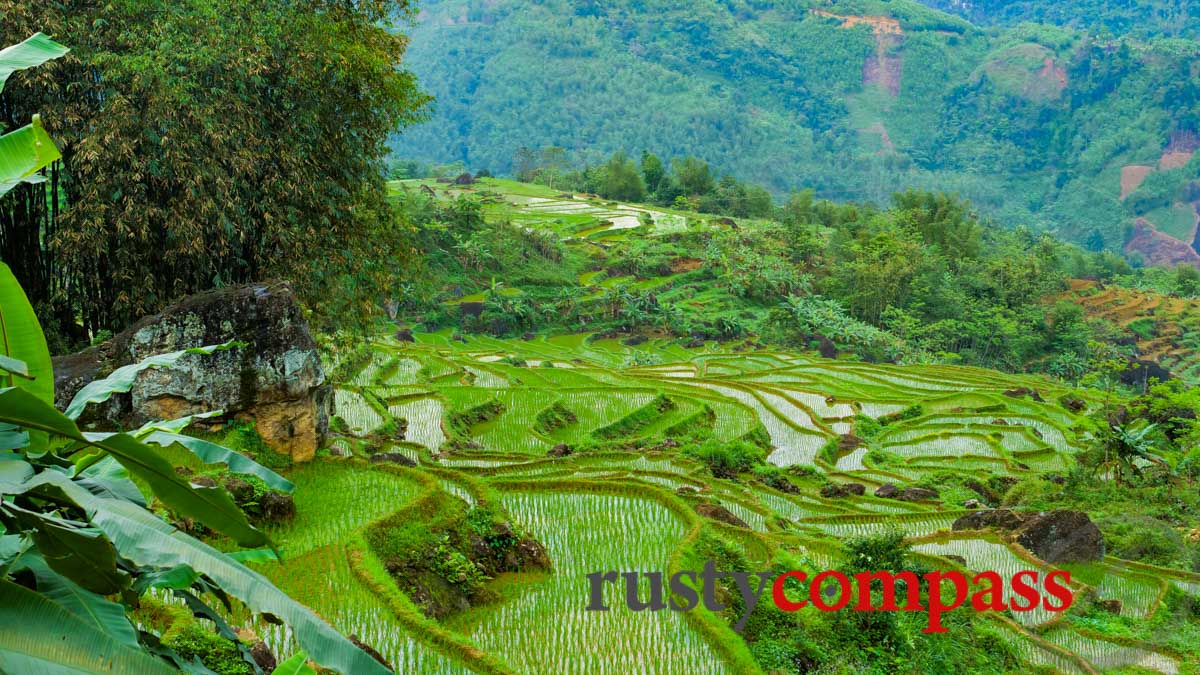
Photo: Mark Bowyer Pu Luong rice terraces - Vietnam
* Hanoi - The clash between tradition and modernity plays out on Hanoi’s streets every day - and it isn’t always pretty. Stunning architecture, amazing streets for photography and food - and an atmosphere unlike any place on earth.
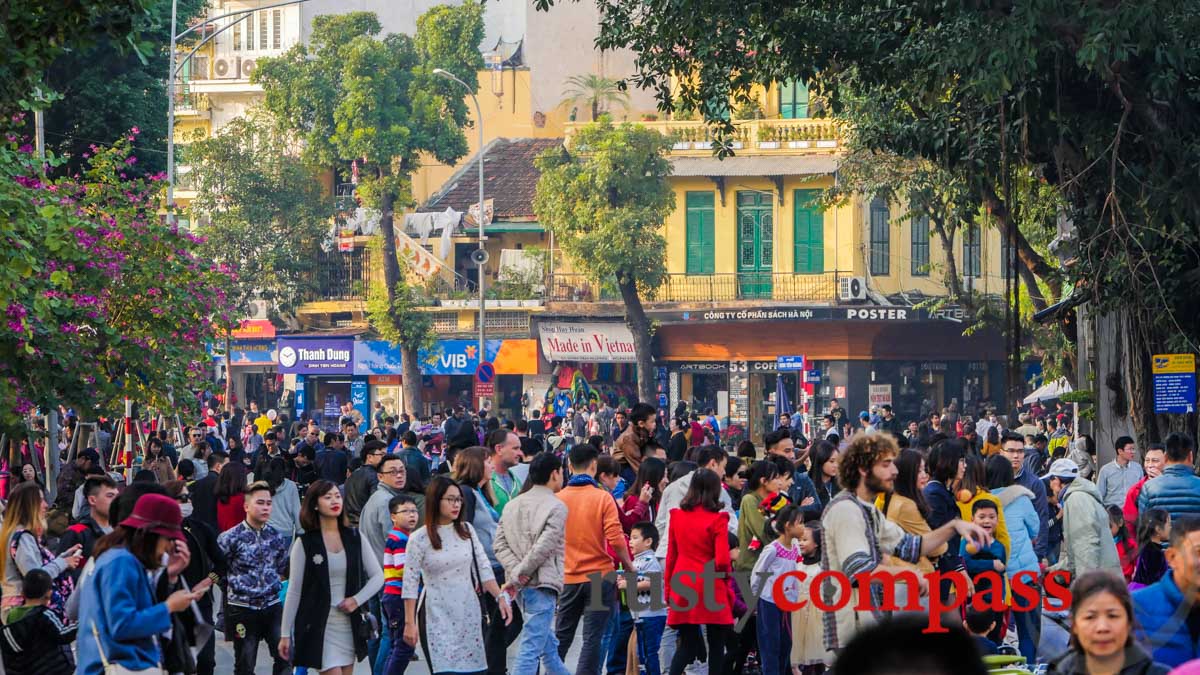
Photo: Mark Bowyer Hanoi's weekend walking precinct.
* Halong Bay may be a mass tourism cliche, but it’s earned its place. Do it. Head to Cat Ba Island and Lan Ha Bay for a slightly less over-touristed experience of this World Heritage listed marvel.
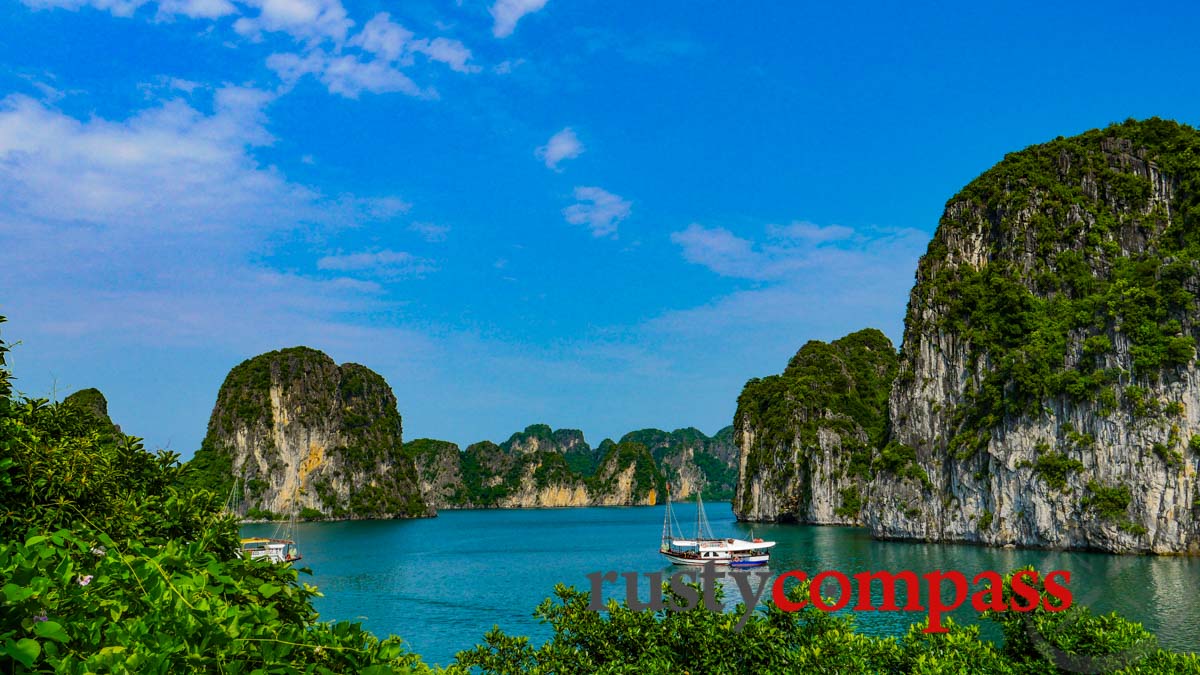
Photo: Mark Bowyer Halong Bay day trip - Bai Tu Long
* Phong Nha Ke Bang National Park is a relatively recent arrival in Vietnam travel itineraries - beautiful caves in spectacular limestone mountains dotted with quaint villages along the old Ho Chi Minh Trail. That's a formidable combination and a great place to spend a few days.
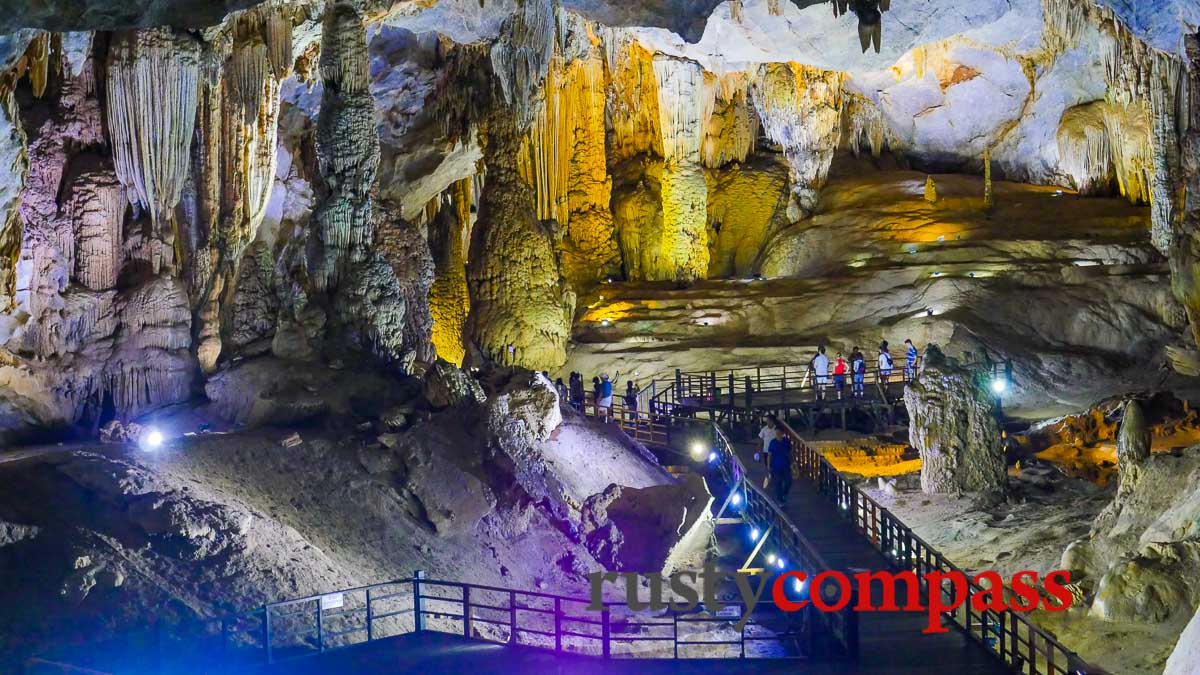
Photo: Mark Bowyer Paradise Cave, Phong Nha
* The old capital of Hue is a personal favourite - but it takes some effort. Great for photographers and historians. So much to see and such a huge role in Vietnam's turbulent modern history.
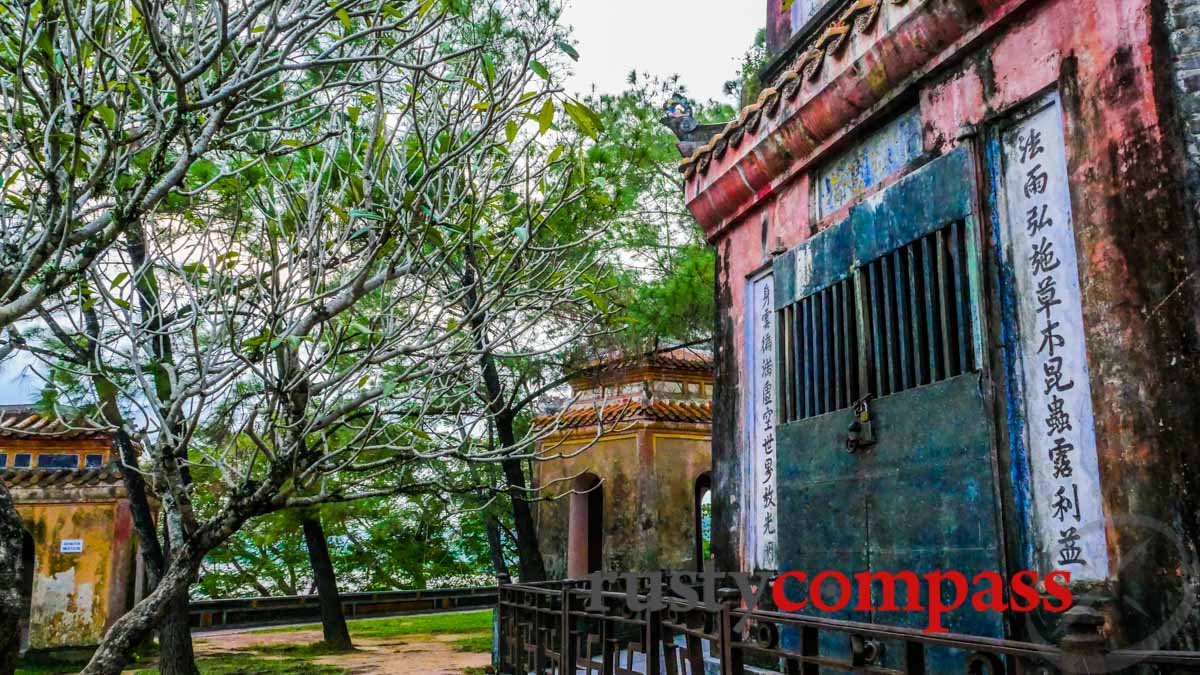
Photo: Mark Bowyer Thien Mu Pagoda, Hue
* Hoi An and My Son - Hoi An’s World Heritage listed old streets are loved by travellers - perhaps too much at times. It’s one of Vietnam’s most popular stops. There’s amazing food, rural life and beaches too. Check our tips for avoiding the crowds.
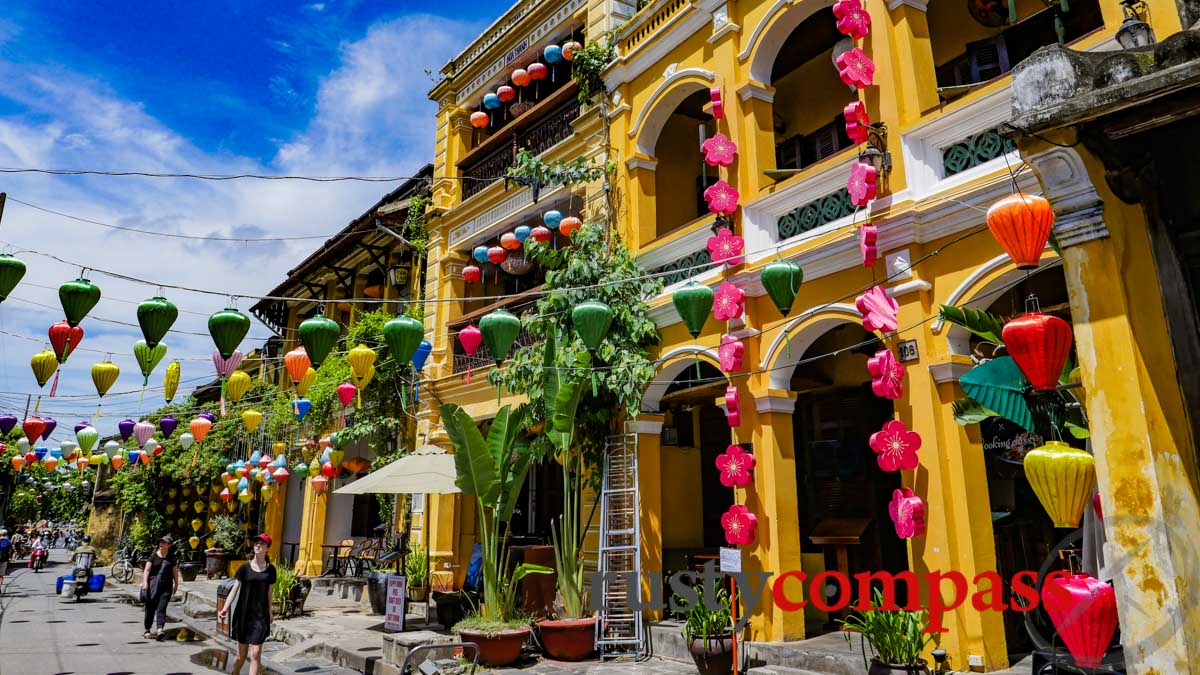
Photo: Mark Bowyer Hoi An's magical old streets
* Ho Chi Minh City (aka. Saigon) - Crazy, chaotic, hyperactive, intoxicating, delicious. You'll most likely love the place in spite of itself.
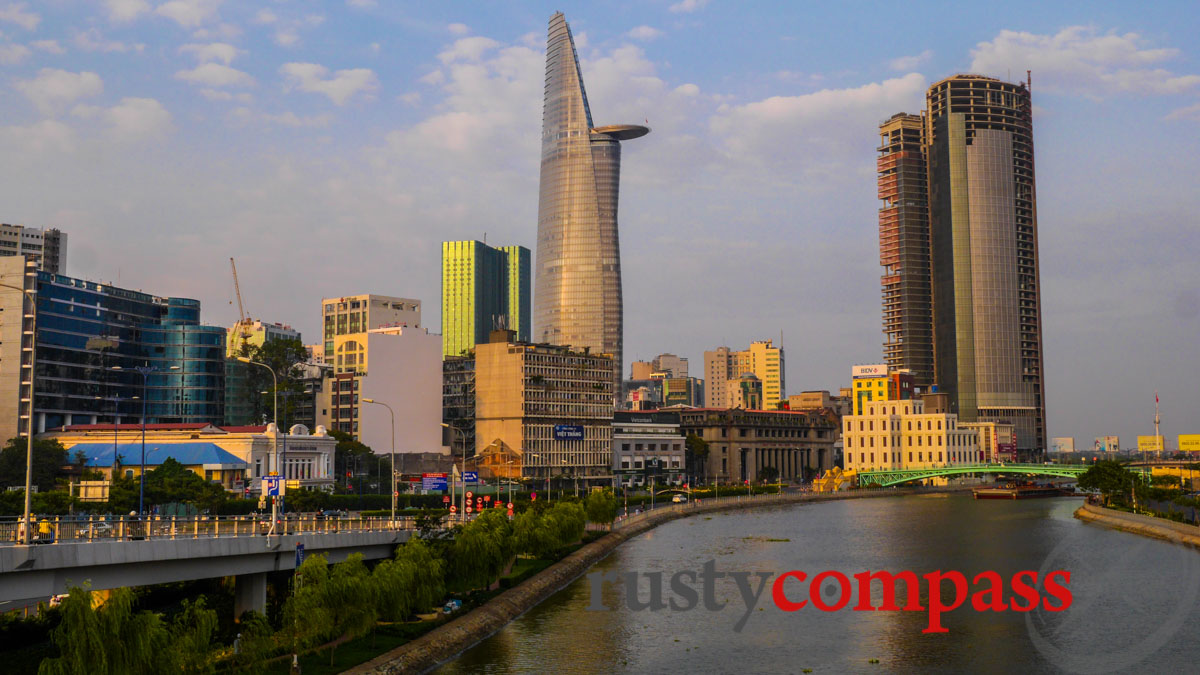
Photo: Mark Bowyer Saigon's Ben Nghe Canal from Calmette Bridge
* The beaches - Phu Quoc Island is racing towards overdevelopment, Con Dao is historic, beautiful and moving less rapidly. Nha Trang and Mui Ne are well established - in Nha Trang's case read "too established". If less developed coastline is your preference, some of the best patches are between Nha Trang and Hoi An and South of Nha Trang. Hoi An's An Bang Beach remains a favourite for its vibe.
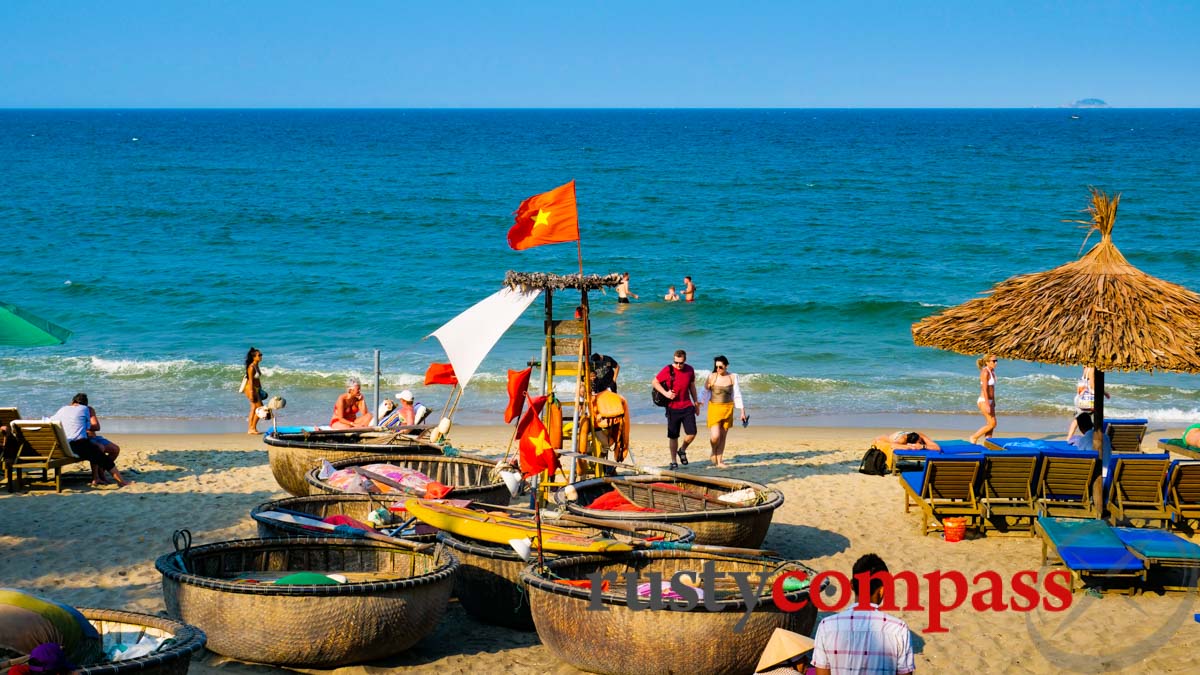
Photo: Mark Bowyer An Bang Beach, Hoi An
* Dalat - one time French colonial retreat may be staging a comeback. The cool mountain air, coffee culture and some tasteful renovations of old villas are driving a renewal.
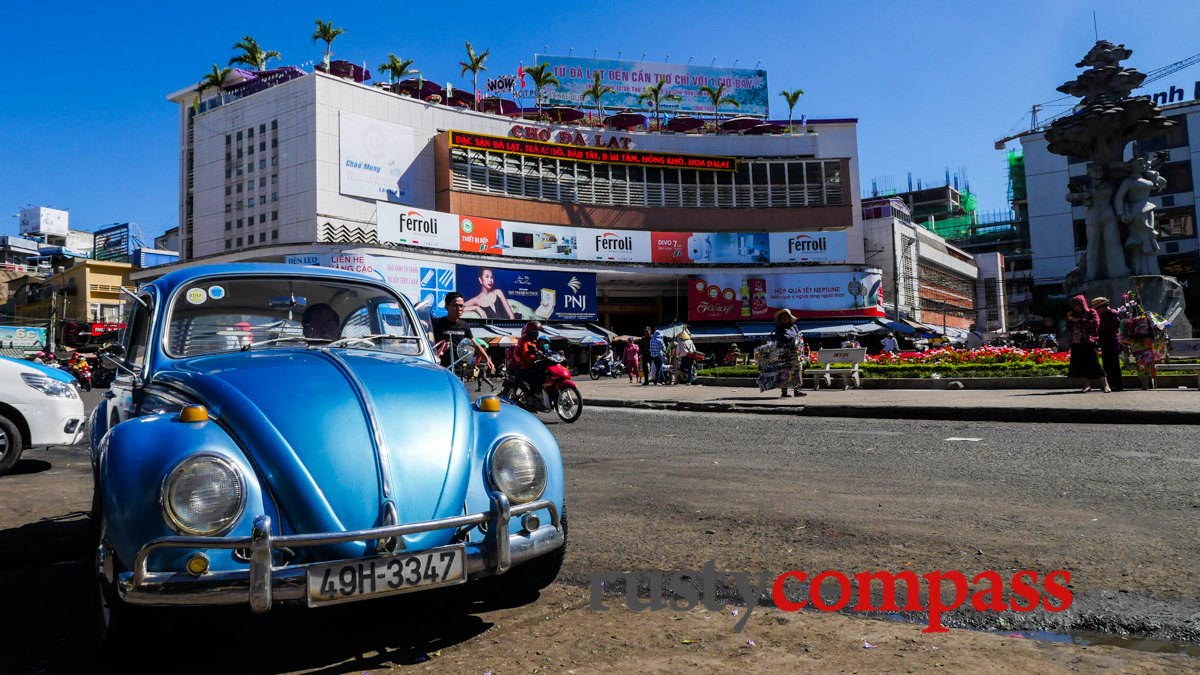
Photo: Mark Bowyer A retro moment at Dalat's modernist central market.
* Mekong Delta - rice paddies, fruit orchards and wooden boats in narrow, tree shrouded canals - life on the Mekong.
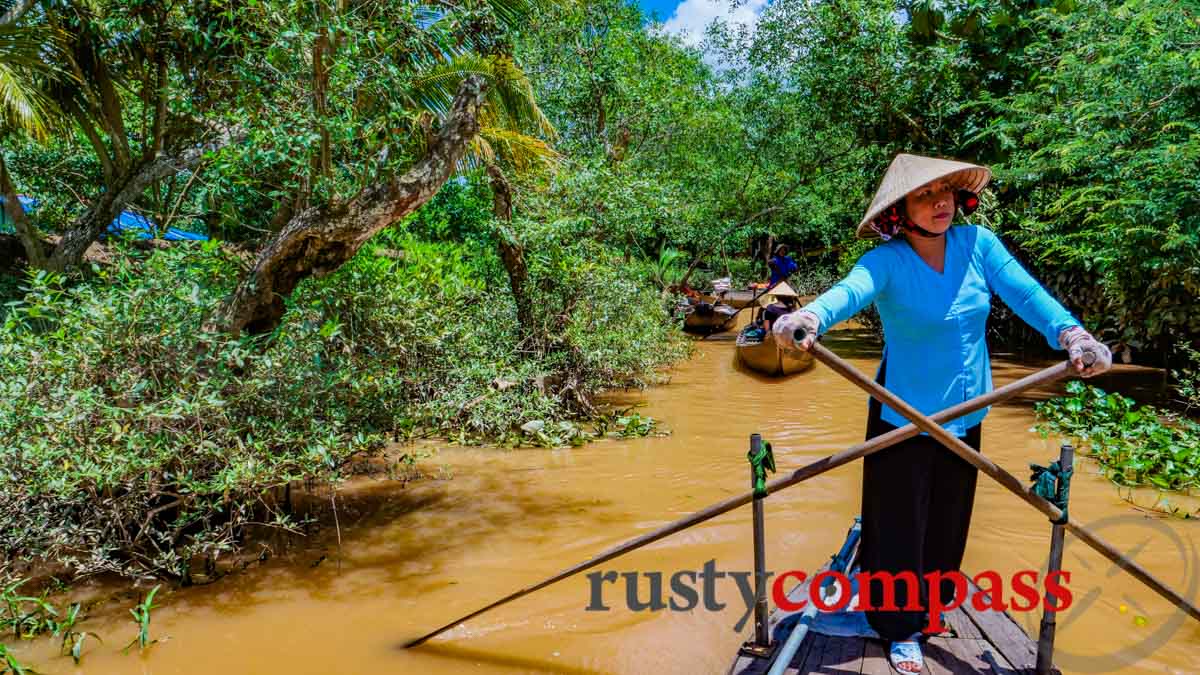
Photo: Mark Bowyer Mekong Delta, Vietnam
Check our menu for details on all these places.
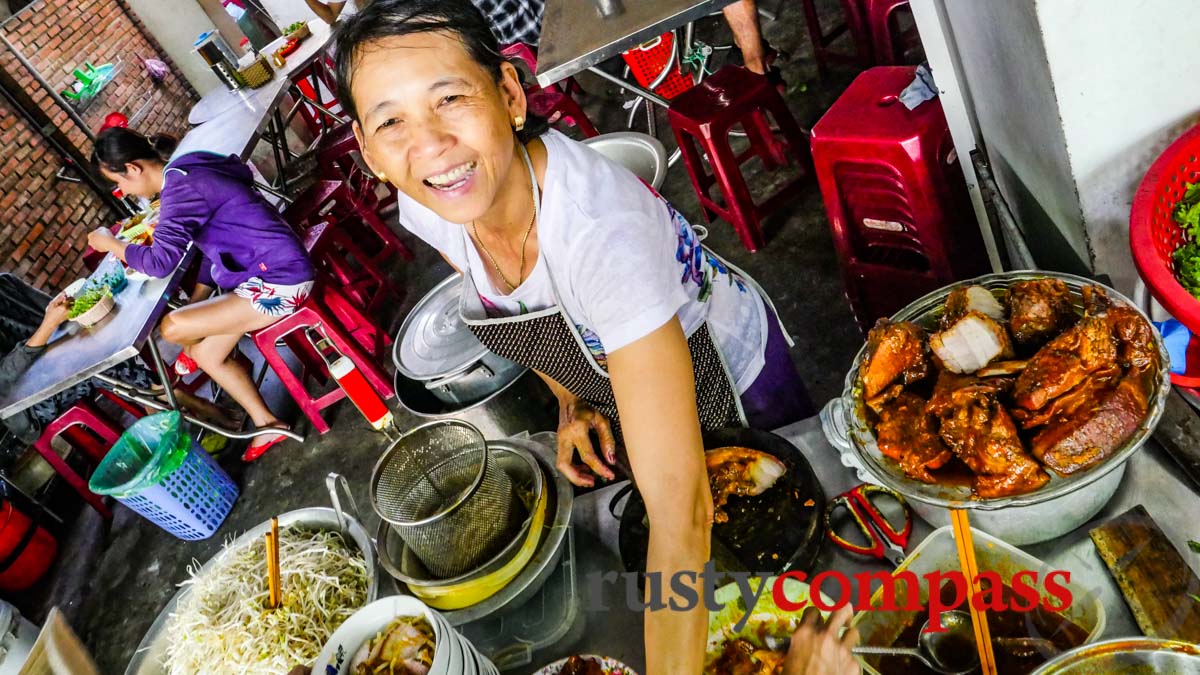
Photo: Mark Bowyer Madam Lien's famous cao lau stall, Hoi An
more introduction….
Vietnam offers a welcome that is warm and convincing. Any postwar bitterness is well hidden. The atmosphere, especially in the south, is exuberant.
The commerce may be too much at times, but the positive energy of the place will sweep you up.
And there’s plenty of diversity. The spectacular mountain country of the far north with hilltribes and rice terraces seems galaxies away from the agricultural frenzy of the Mekong Delta. In between, there are rapidly changing cities, the history of Hue and Hoi An and a coastline sporting stunning beaches and islands.
Vietnam’s cuisine and its shopping are also winning the hearts of travellers.
Rusty Compass has comprehensive, independent guides for the cultural, culinary and historical traveller to all of Vietnam’s major destinations.
If you like what we do and would like to make a contribution, click below. Even small amounts help.
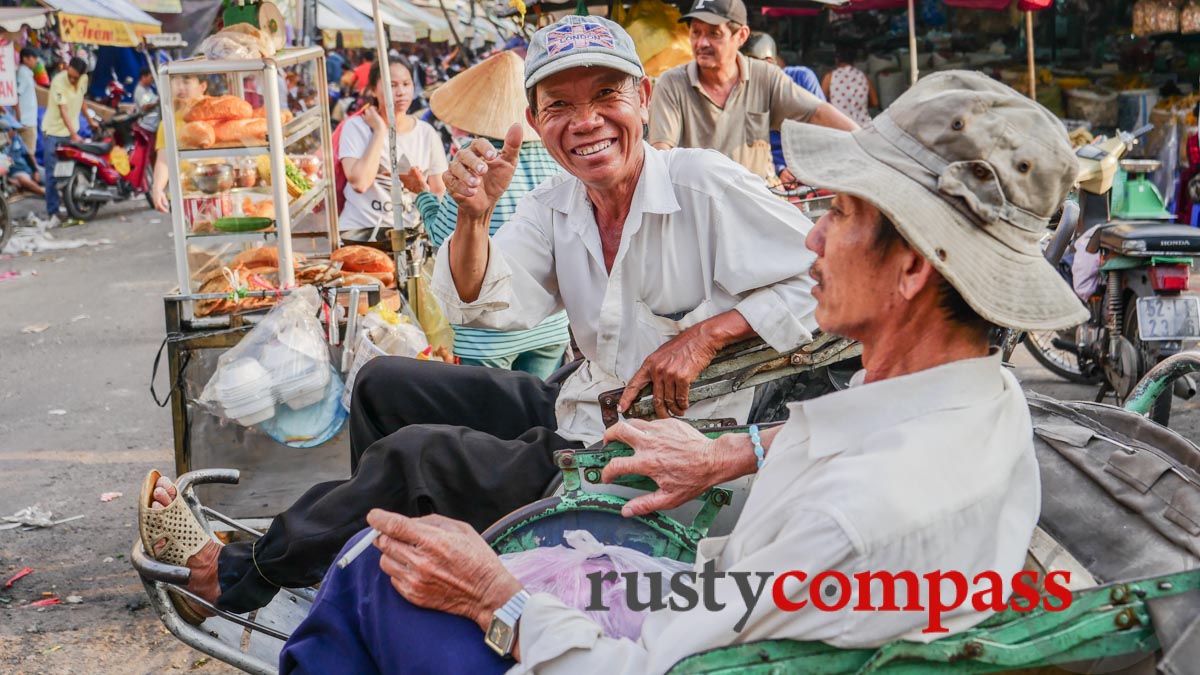
Photo: Mark Bowyer Cyclo drivers - Cholon, Saigon
Vietnam background
Two decades ago Vietnam was struggling to shake off the impact of war and hardline communism. Now, it’s dealing with the dilemmas of rapid economic growth. In 2018 Saigon opened South East Asia’s tallest building, Hanoi signed on for the Grand Prix and a homegrown luxury car, the VinFast, was launched. Vietnam is racing to nail the symbols of prosperity. But there’s a long way to go.
Happily, Vietnam’s best features endure, and they’re the things we love most - the energy and friendliness of the people, magnificent landscapes, chaotically charismatic cities and one of the world’s most delicious cuisines.
In a little over two decades, tens of millions of Vietnamese people, of a population of 90 million, have been lifted out of poverty. Young Vietnamese now have access to a globalised digital lifestyle unimaginable to their parents. And they’ve embraced it with gusto. And this extraordinary generational spectacle is on display across the country.
But rapid development is posing new challenges. Pollution, soaring inequality and corruption, destruction of environment and heritage, and previously unheard of health challenges like obesity and diabetes, are now major concerns.
Vietnam key facts
Population - 95 million
GDP (2017) - $225 billion USD (US - 19 trillion, China = 12.2 trillion, Japan 4.8 trillion, UK - 2.6 trillion, Australia - 1.3 trillion).
Life expectancy - 76 (US - 78, UK - 81, Australia 82.5, Japan - 84, China - 76)
Health care spend (2017) per capita - $122.84US (US = $9869US Japan = 3700, UK = $4300, Australia = $4,700).
PISA mathematics ranking = 22, (US = 40, Japan = 5, Singapore = 1, United Kingdom = 27, Australia = 25)
Big national challenges
i) Global warming - Vietnam is projected to be one of the countries most seriously impacted by global warming.
ii) Geopolitics - The East Sea (South China Sea) is a major geopolitical hotspot. Balancing positive ties with China, the region and the US will pose complications.
iii) Regional prosperity - Vietnam is a beneficiary of the booming regional economy and is dependent on the region's continuing growth. COVID and China issues have made Vietnam an especially popular location for tech manufacturing. Samsung and now Apple have big projects.
iv) Environment - Vietnam’s rapid economic growth has taken a serious environmental toll. Hanoi's air quality is poor much of the time. Saigon is slightly better.
v) Health - Vietnam faces numerous health challenges with diet and lifestyle changes accompanying increased prosperity. Access to international standard healthcare has improved with greater prosperity.
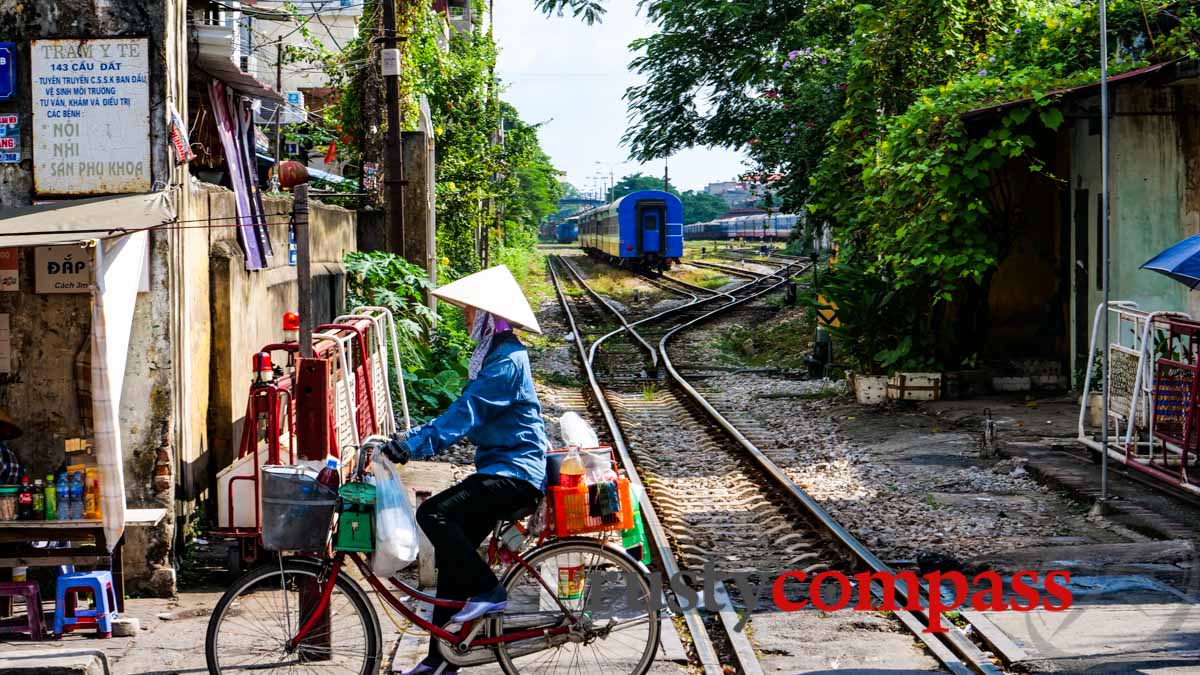
Photo: Mark Bowyer Off the rails - Haiphong, Vietnam
Vietnam weather guide - Best time to travel?
Here are the simple things to remember about Vietnam's climate.
Hanoi and the north experience three seasons - grey moist and cool winters, hot humid summers. Hanoi’s best in March / April and October / November. Saigon and the south are always warm to hot. April and May are the hottest months. The dry runs from December to April.
Central Vietnam around Hoi An and Hue have a mild winter, hot summer (it can be very warm between March and October) and keep an eye out for flooding and typhoons in October and November.
The respective "best" months in Vietnam's regions tend not to coincide. We reckon travel is good any time of year - but conditions vary. So here are some weather tips to factor into your planning.
We like it best in the hot, wet months of June, July and August. The rice paddies and mountains are lush, beaches beckon and the afternoon storms are a great spectacle. Oh - and the occasional day might be lost to rain. But some enforced downtime can be a nice thing too. It will be hot and sweaty.
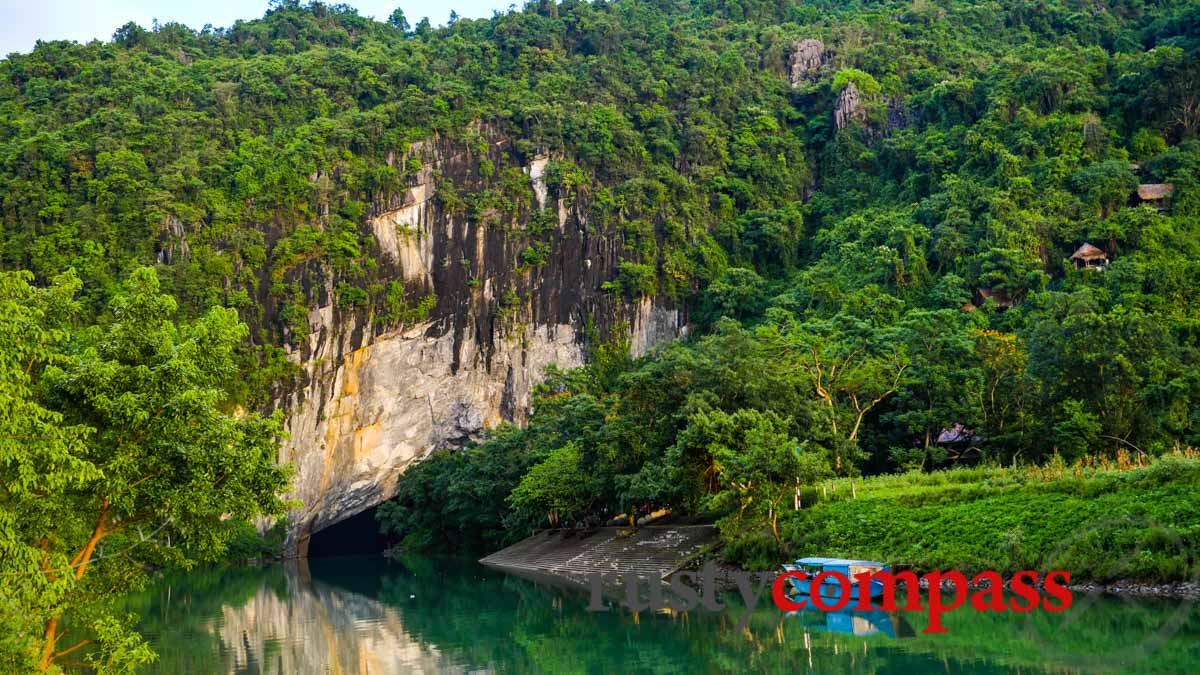
Photo: Mark Bowyer The entrance to Phong Nha cave
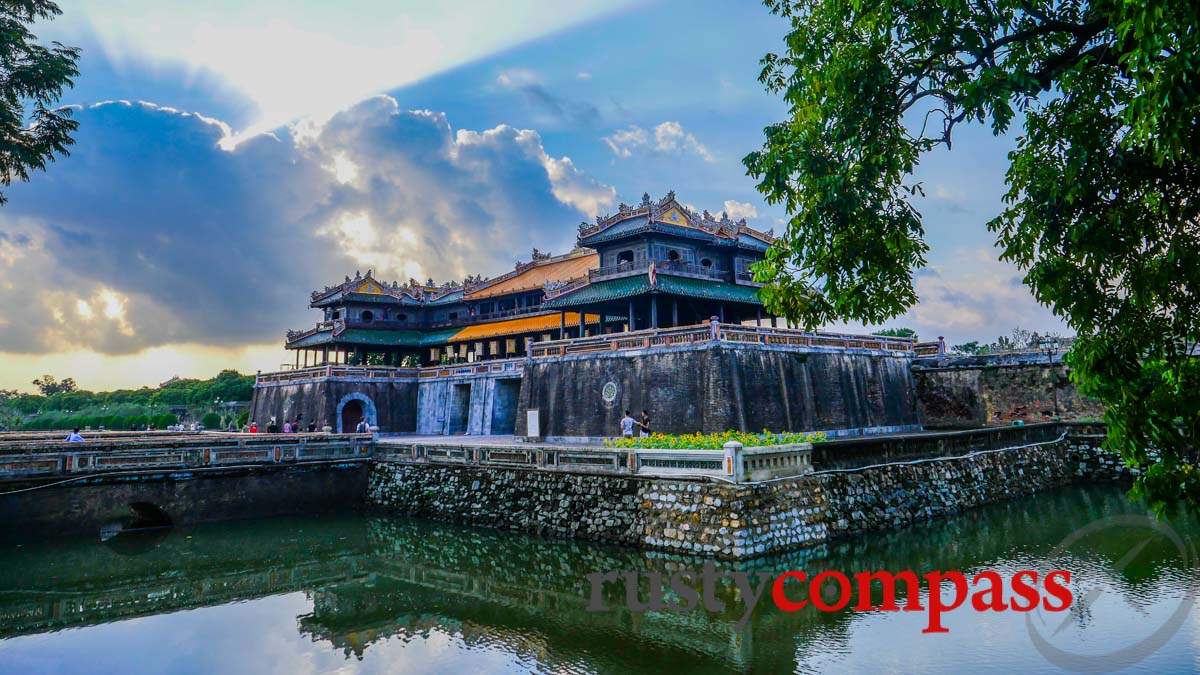
Photo: Mark Bowyer Hue Citadel - Ngo Mon Gate
Getting to Vietnam
Arriving at international airports
Vietnam’s main international gateways are its airports in the capital Hanoi - Hanoi Noi Bai, and the commercial centre of Ho Chi Minh City (Saigon) - Tan Son Nhut in the south. Danang airport in central Vietnam is becoming a significant international gateway as well.
The national carrier Vietnam Airlines has an extensive regional and international network. A number of budget regional carriers including Jetstar, Vietjet, Air Asia, Scoot and Tiger Airways operate services into Saigon, Danang and Hanoi out of Singapore, Bangkok and Kuala Lumpur. Local budget carrier Vietjet is rapidly expanding its international network and offers some competitive fares to many major regional centres. Bamboo Airways is a new player that is making its mark with a growing domestic and international network.
Arriving by land
An increasing number of travellers to Vietnam choose to use land borders to enter and or depart the country. This is especially practical if you’re travelling from Phnom Penh in Cambodia into Ho Chi Minh City and vice versa or through Vietnam’s Mekong Delta crossings at Chau Doc and Ha Tien into Cambodia.
Overland crossings from Vietnam into Laos and China are also an option - usually for travellers with time on their hands and a readiness to take on some long rides in public transport.
The most commonly used international border crossings for Vietnam are -
Borders between Vietnam and Cambodia
Moc Bai (Vietnam) and Bavet (Cambodia) - for travel between Phnom Penh and Saigon
This is Vietnam’s most commonly used land border for travellers. The journey between Saigon and Phnom Penh is inexpensive, comfortable and travel times are down to around 5 - 6 hours. Dozens of buses of varying quality now operate on this route each day. Prices are around US$15 each way. Fares for the 20 minute flight are between 5 and 10 times more expensive for a saving of perhaps of 2 - 3 hours.
Vin Xuong (Chau Doc) Vietnam / Kaam Samnor (Cambodia) - for travel between Chau Doc (Mekong Delta) and Phnom Penh
This is the river crossing from Vietnam’s Mekong Delta to Phnom Penh. Multiple boats of varying quality run this route and can be booked in Chau Doc. The journey takes around 4 hours. Chau Doc is an interesting Mekong Delta town too.
Ha Tien - for travel between Ha Tien (Vietnam) and Kep (Cambodia)
For travel between Phu Quoc Island, the Mekong Delta and southern Cambodia
A less frequently used border, this is the gateway to Cambodia’s beautiful southern coast and is especially convenient for those travelling from Phu Quoc Island into Cambodia and vice versa.
Borders between Vietnam and Laos
These border crossings are popular with backpackers and those with plenty of time. They involve long road journeys - often on scenic but bumpy roads. Be ready to rack up a few traveller’s tales.
Dansavanh / Lao Bao - for travel between Hue and Savannahket / southern Laos
Nam Phao / Cau Treo - for travel between Vinh in central Vietnam and Vientiane and other points in Laos
Borders between Vietnam and China
Vietnam has two main border crossings with China. The most popular is at the Friendship Gate just beyond the Vietnamese city of Lang Son. The second is at Lao Cai which is also the main rail stop for travel to Sapa. These borders, like those in Laos are for travellers with plenty of time and patience.
Friendship bridge - for travel by road or rail from Hanoi and Lang Son to Nanning and on to Beijing.
Lao Cai - Hekou - for travel by road from Sapa into China. Hekou is 400+ kms from Kunming
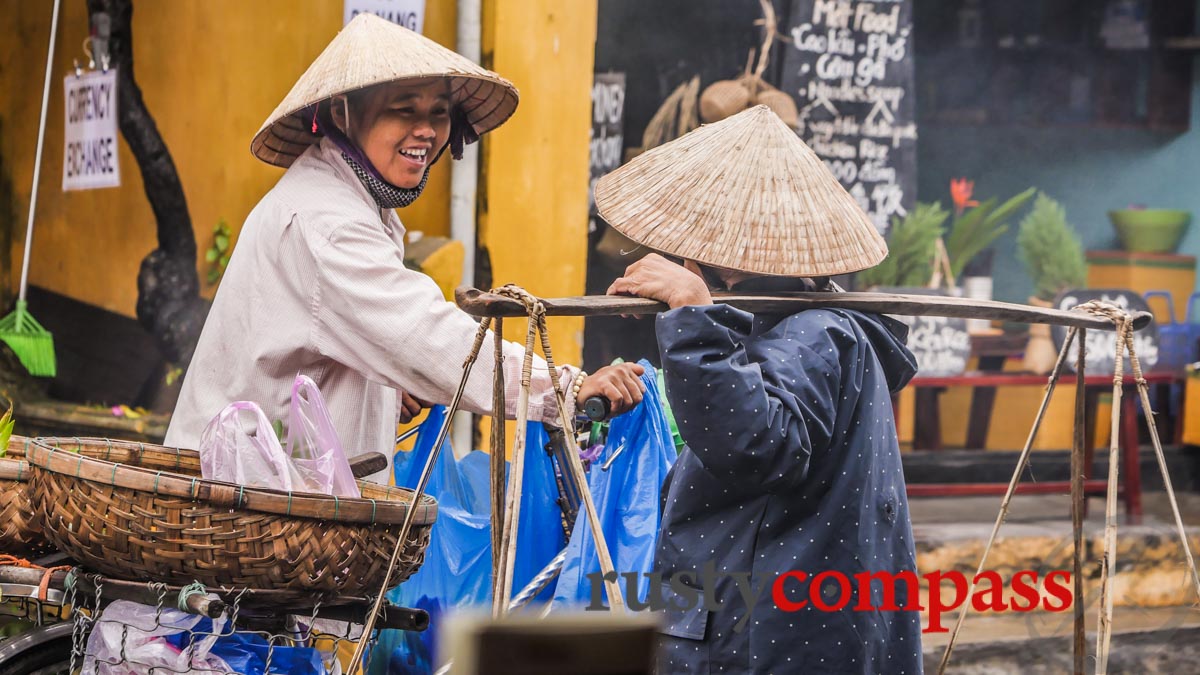
Photo: Mark Bowyer Hoi An streets
Getting Around in Vietnam
Most travellers to Vietnam will use a combination of flights and road travel to get around. There are airports at all major centres and the Reunification Express train runs the length of the country between Hanoi and Saigon. Inexpensive and regular bus services covers the whole country too. The introduction of luxury mini buses and improved roads has made road travel easier and more comfortable.
Popular train services for travellers operate between Hanoi and Lao Cai for travellers heading to Sapa, Hanoi and Hue, Hue and Danang and Phan Thiet (Mui Ne) and Saigon. And of course you can take the train the whole way if you wish.
Vietnam’s not particularly large so overland travel is practical. Domestic airfares are cheap so it’s not unusual for travellers with time to cover the whole country overland - either by road or rail.
Getting around Vietnam by air
Vietnam's domestic aviation market is huge so the country's airlines survived COVID better than many. There are now four domestic airlines - Vietnam Airlines, Pacific Airlines (owned by Vietnam Airlines) Vietjet and a 2018 arrival, the curiously named Bamboo Airways. Domestic air travel is comfortable and straightforward and good value for money.
Vietjet is the main alternative to the big national carrier Vietnam Airlines and offers sharp prices on a network that covers most destinations. Bamboo Airlines has a smaller network but looks to be growing quickly. We've already taken several flights on Bamboo Airlines - all good so far!
Be careful of baggage allowance rules - especially with the budget carriers. Excess baggage charges at airports are punitive.
Getting around Vietnam by rail
The Reunification Express train operating between the capital Hanoi and Saigon in the south can be a good option for part of your Vietnam journey assuming time is not an issue. Fares are cheap and sleeper cabins (usually four berth) are basic but clean and comfortable enough. Travel between Hue and Hanoi and vice versa is common for travellers. Ninh Binh is easily accessed from Hanoi and Phan Thiet is a nice ride from Saigon.
There are small higher quality services opening on selected sections of the national rail line.
Getting around by road
There’s no avoiding plenty of time on Vietnam’s dangerous and chaotic roads during your travels here. Inexpensive bus services operate along the coast between Hanoi and Saigon. Time rich travellers - mostly backpackers - traverse the whole country by road. Other common road journeys operate into the Mekong Delta, between Hoi An to Hue (3 hours), Hanoi and Sapa (5-6 hours) and the journey to Halong Bay (3 hours). There are rail alternatives on these routes but road travel is quicker and usually good value for money - especially when two or more travellers are together. The quality of road transport has improved and luxury mini-buses operate between some major tourist centres.
Taxis and rideshare services in Vietnam
Grab is the Uber of Vietnam. Download the app and you'll access reasonably reliable rideshare cars and motorcycle services (and other services). Grab has become less reliable since COVID, drivers rarely speak any English. They are normally reliable once you're aboard. Know where you're headed and keep an eye on maps.
Cycling in Vietnam
We love cycling and it's a practical option around many of Vietnam’s towns. Long haul cycles tend to be for the very committed. Dangerous roads make it a precarious pursuit. Seek out backroads and country lanes. Most travellers choose to confine cycling to specific destinations. Hue, Hoi An, Phong Nha and the Mekong Delta are good places for casual cycling. Serious cyclists may struggle to find quality bicycles to rent in most places.
Vietnam by motorbike
If you're thinking of making your way around Vietnam by motorbike, keep in mind that roads can be very dangerous and your travel insurance probably won't cover you in the event of an accident (unless you're a fully licensed motorcyclist and all other paperwork is in order).
Many travellers have been killed and injured on Vietnam's roads. Many families have been dealt the double blow of having a loved one seriously injured and then receiving an horrendous bill for their medical treatment. Think carefully before you decide to jump on a motorbike - alluring as the idea is!
Vietnam is not the place to learn how to ride a bicycle or motorcycle.
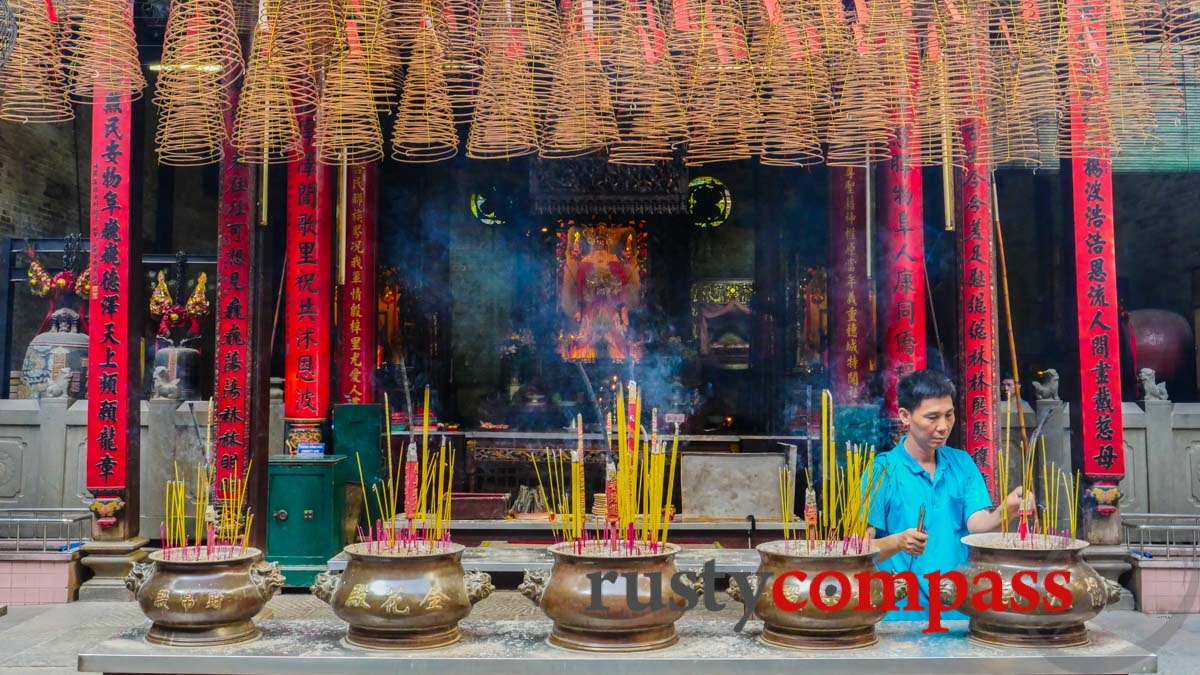
Photo: Mark Bowyer Thien Hau Pagoda, Cholon
Health and Safety - Vietnam
Vietnam is a safe travel destination by world standards. Serious crime against travellers is rare - though petty street crime such as phone, camera and bag theft are a common problem - especially in Saigon and Nha Trang. Scamming of travellers is more of an issue. There are a number of additional hazards that travellers should be aware of and we list them here.
Crime against travellers in Vietnam
While serious crime against travellers in Vietnam is rare, petty crime is common and increasing. The most common crimes against travellers are phone theft, bag slashing / snatching and motorcycle drive by bag snatching.
Motorcycle drive-by snatching has led to serious and fatal falls. Don’t carry unnecessary valuables or wear clothing and jewellery that may make you a target. Ensure that you have your bag held close to your body and be especially wary of your valuables - as well as the traffic - when crossing busy roads. Be careful when using your camera and phone on city streets.
Violent crime against travellers is rare. Common sense rules of safety - staying away from dangerous areas and situations - should ensure safe, happy travels. Violent brawls in some of Saigon’s late night establishments have been reported in recent times. Saigon’s Bui Vien backpacker area can get nasty late at night.
There have also been reports of violent crime in Nha Trang and Cat Ba.
Scams
While serious crime is rare, scams are more common. They are particularly prevalent in the backpacker district. Common scams include taxi, cyclo and xe om (motorcycle taxi) rip offs and intimidation. There are many dubious taxi operations in Saigon and Hanoi. Reputable companies will tend to have newer, better vehicles. Try and have an idea where you are headed before you go out. With cyclos and xe om (motorcycle taxis), negotiate a fixed price before you board.
Dodgy taxis congregate at airports and target travellers at popular tourism destinations such as airports, the War Remnants Museum in Saigon and Ba Dinh Square and the Old Quarter in Hanoi.
It often pays to have a regular taxi, xe om or cyclo driver for a few days. That way you'll develop some trust and probably have some fun as well.
The most popular ride-share service in Vietnam, Grab, tends to be more reliable and accountable. It's like Uber in Vietnam and it offers car and motorcycle taxi services in most major centres.
There are a countless number of other scams that common sense and caution will reduce your exposure to.
Be very wary of “students” or other people making appeals for your charity on the street or offering unsolicited hospitality. Avoid money changers on the street.
Many cheap hotels recommend poor quality and overpriced tours and transport services. Check with other travellers or online before booking services from a hotel.
Some travellers have been confused by the currency. Don’t mistake 50K and 500K Vietnam Dong notes.
Saigon and Hanoi airports are havens for scammers. Either take a prepaid taxi for a small premium or choose a reputable taxi company. Public bus services from Saigon and Hanoi are an cheap and reasonable option too.
Police when travelling in Vietnam
Fortunately, you are unlikely to require the services of the police during your travels in Vietnam. If you do, be warned that they tend to be disinterested and unhelpful. The most common need for police assistance for travellers is for the provision of a police report of a theft. A police report should be provided without a fee.
You will likely need an interpreter for your police dealings - even in tourist districts. Be polite and respectful with police at all times.
There are increasing reports of police enforcing license rules for motorcycle riders. If you're not licensed, you may be fined or you may lose your bike.
Safety for travellers in Vietnam
Vietnam’s roads pose the biggest safety risk to travellers. The number of trucks, cars and motorcycles continues to grow quickly and all vehicles view pedestrians with equal contempt. Pedestrian crossings should be ignored as they are by local drivers. You should also be wary on pavements as motorcyclists will regularly mount these at high speed to get around a traffic snarl. They will expect you to know they are coming and make appropriate space for them.
There seems to be have been a spike in recent years of young backpackers dying or suffering serious injuries in motorcycle accidents. Inexperienced and unlicensed foreigners are finding themselves no match for the inexperienced, newly arrived and often careless drivers of trucks and cars.
General safety standards in Vietnam are not high. In addition to the roads, travellers should also be wary of boats, hotel electrical fittings and road and construction works.
Staying healthy in Vietnam
Vietnam’s health system has not kept pace with the country’s development so it pays to try and stay healthy while here. There are now a number of international standard facilities in Saigon, Danang and Hanoi, however they are only able to provide world class healthcare across a small range of health complaints. Outside of these cities, health facilities are basic.
Many serious health conditions require evacuation to Singapore, Bangkok or other Asian cities. Travellers should have good medical insurance including evacuation insurance in the event of serious illness or injury. Remember that unlicensed riding of a motorbike will void your insurance.
There are a number of steps you can take to minimise health risks while in Vietnam -
* Drink only bottled water - (bring your own refillable bottle to avoid adding more plastic waste).
* Use mosquito nets where these are necessary. They will normally be provided in accommodations where there is a risk.
* Eat street food with care. Eating street food and fresh salads is one of the joys of travelling in Vietnam. It can also be unhygienic. There is no easy way around this risk but use some common sense when choosing where and what to eat - and how much uncooked food you’re ready to risk. It’s also worth noting that while stomach upsets are common while travelling, serious food related illness is not common.
* See your doctor before you travel and take advice on other health precautions.
* Stay hydrated. Dehydration is a major cause of illness. Drink lots of water.
Cash and cards in Vietnam
The local currency is the Vietnamese Dong (VND) - we’re done with dong jokes. At time of writing (October 2022), US$1 = 23,900VND. While US dollars are widely accepted, you’re better using the dong as much as possible as there is usually a premium charged for US dollars.
ATMs accepting foreign cards are now found all through Vietnam so it’s possible to minimise the amounts of cash you carry. It makes sense to keep a few hundred US dollars spare in case there are bank or card problems but we’ve found them very reliable. It’s also a good idea to travel with more than one ATM card if you plan to make the ATM your main source of cash during your travels.
Credit cards are widely accepted at international hotels and large shops catering to tourists. They are less widely accepted at smaller hotels, shops and restaurants. Most local hotels will levy a 3% charge on credit card transactions. Most locally run hotels do not accept American Express or Diners cards.
Tap services like Apple Pay and Google Wallet are also in use though less extensively than many other countries.
International hotels usually accept all cards without surcharge.
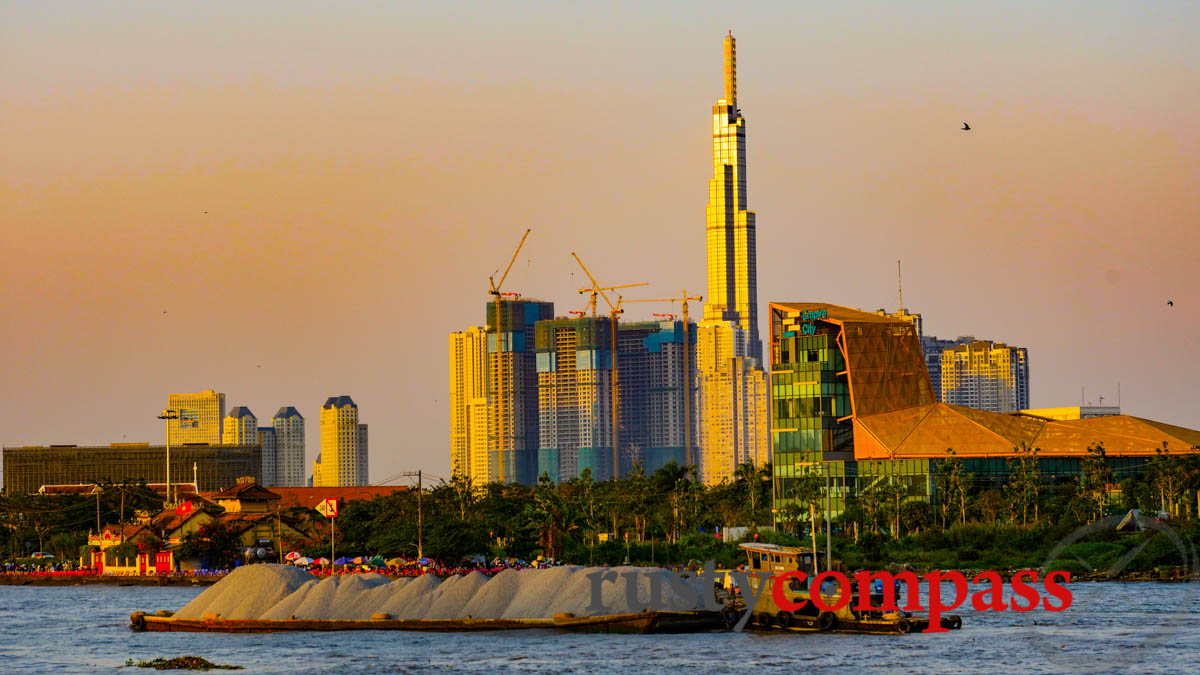
Photo: Mark Bowyer Landmark 81 - South East Asia's tallest building - in Saigon
Mobile phones and internet in Vietnam
Vietnam has excellent and inexpensive 3G - 4G mobile services. Grab a SIM card on arrival at any international terminal. Viettel is said to have the most extensive network if you’re travelling to remote areas. Vinaphone and Mobifone are also fine. You can purchase SIM cards with ample data and call credits for your holiday.
Internet access is ubiquitous throughout Vietnam. Free wifi is a standard feature of most hotels, bars, cafes and restaurants. This includes all the major traveller spots and many more remote places. Local 3G and 4G services are also good.
International calls from Vietnam are expensive from hotels, mobiles and landlines.
Media
Media is tightly controlled in Vietnam. Services like Facebook and Google are facing increasing pressure from the Vietnamese government and are facing tighter regulation in 2019. The best place to catch up with local news in English is at VNexpress.

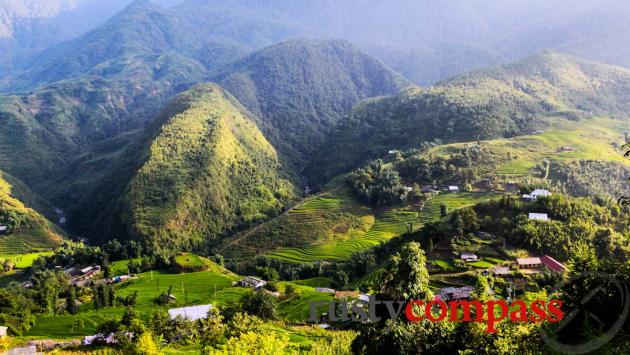
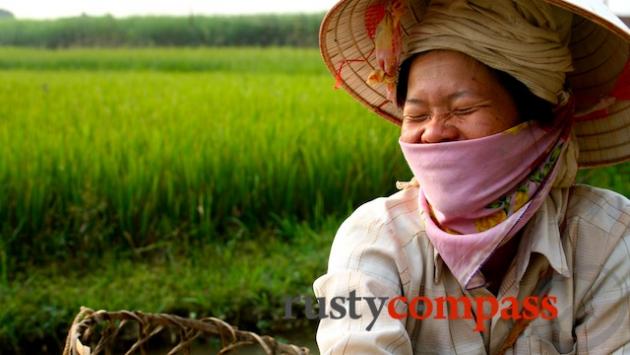
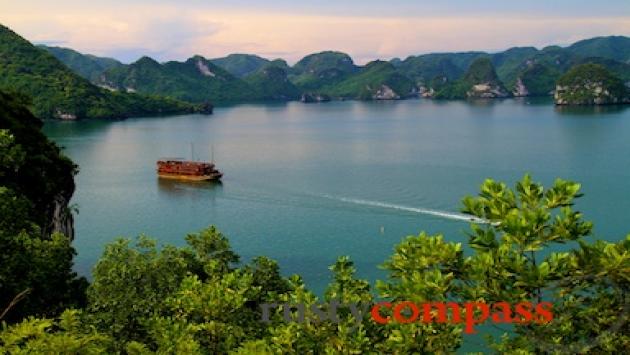
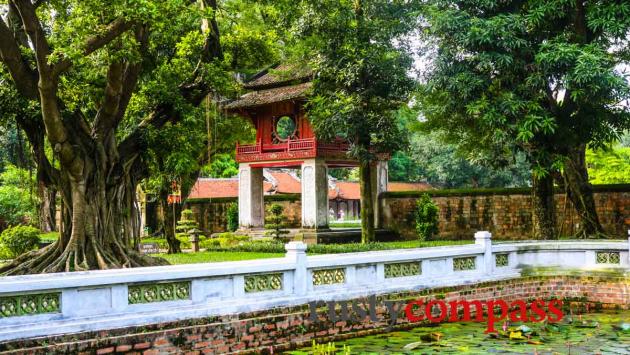
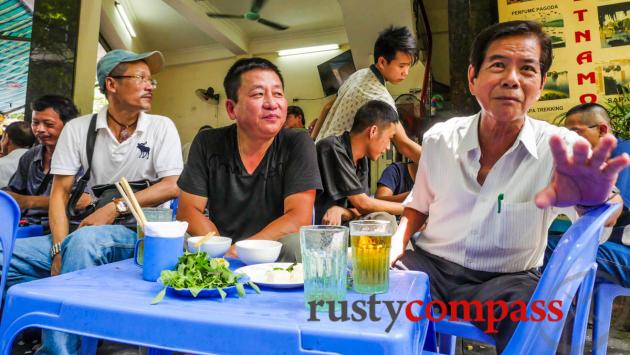
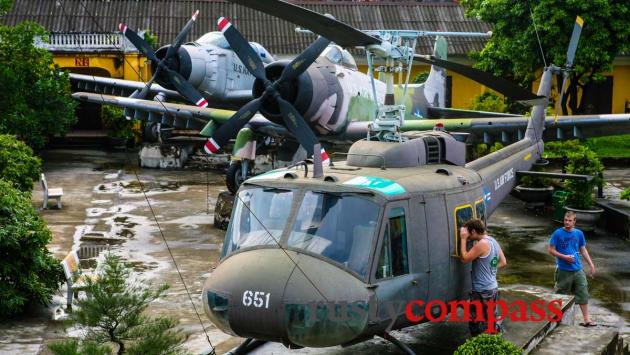
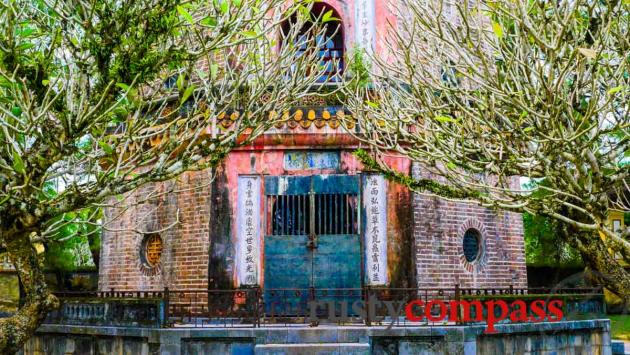
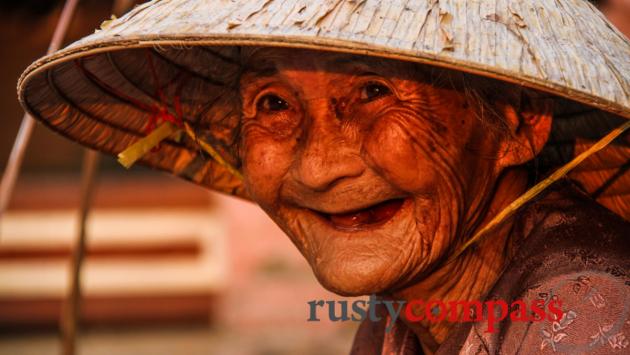
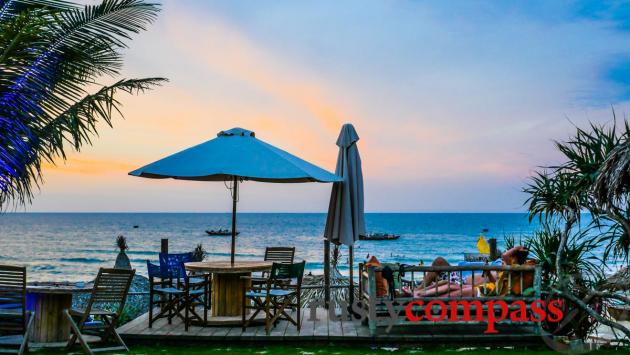
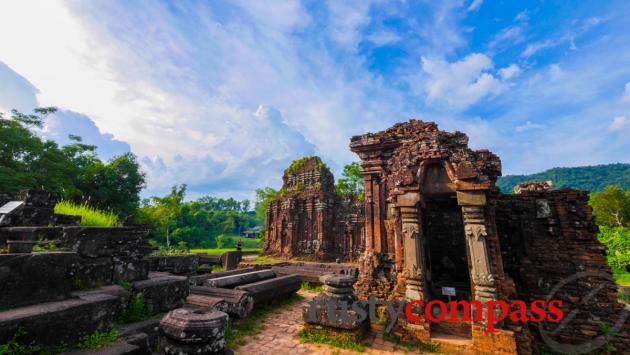






Twitter: @rustycompass
Rusty Compass is an independent travel guide. We’re focused on providing you with quality, unbiased, travel information. That means we don't receive payments in exchange for listings and mostly pay our own way. We’d like tourism to be a positive economic, environmental and cultural force and we believe travellers deserve disclosure from publishers. Spread the word about Rusty Compass, and if you're in Saigon, pop in to The Old Compass Cafe and say hi. It’s our home right downtown on Pasteur St. You can also check out our unique tours of Ho Chi Minh City and Sydney at www.oldcompasstravel.com Make a financial contribution using the link below. Even small amounts make a difference. Thanks and travel well!